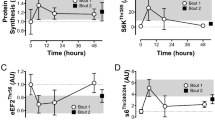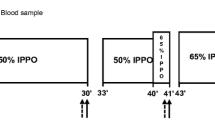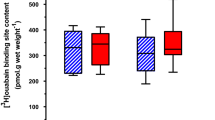Abstract
Kinetics of phosphoryl transfers from PCr to γ-ATP and from β-ATP to β-ADP were measured by magnetization transfer in an in vivo31P NMR experiment in working rat skeletal hind leg muscles. Two groups were examined. One group was submitted to a 6-week training program of treadmill running. The other group was composed of sedentary animals. Metabolic oxidative capacity and mechanical performance were improved greatly by training as shown previously. Phosphoryl transfer of PCr→γ-ATP or β-ATP→β-ADP total fluxes were identical in resting trained and untrained muscles. Under stimulation, the flux of creatine kinase transfer was significantly inhibited by 23% compared with resting level in untrained muscles; by contrast, it was not inhibited and maintained at the high resting level in trained muscles. Thus physiological changes probably linked to a decrease of the production of anions, which could inhibit creatine kinase, were able to maintain creatine kinase flux. The flux of β-ATP to β-ADP transfer were enhanced largely in working muscles from 1.4±0.8 and 2±0.8 at rest to 4±1.6 and 6.6±2.7 mM s−1 for untrained and trained muscles respectively; the effect was more pronounced in trained than in untrained muscles. These results showed an acceleration of phosphoryl turnover in working muscles after training, which could contribute to improve oxidative and mechanical performances. Such kinetic measurements of phosphoryl conversion may provide information on ATP turnover in pathophysiologic situations where ADP accumulates because of impaired ATP synthesis (mitochondrial myopathies, lower perfusion level).
Similar content being viewed by others
References
Booth FW, Thomason DB. Molecular and cellular adaptation of muscle in response to exercise: perspectives of various models. Physiol Rev 1991;71:541–85.
Constable SH, Favier RJ, McLane JA, Fell RD, Chen M, Holloszy JO. Energy metabolism in contracting rat skeletal muscle: adaptation to exercise training. Am J Physiol 1987;253:C316–22.
Holloszy JO, Coyle EF. Adaptations of skeletal muscle to endurance exercise and their metabolic consequences. J Appl Physiol 1984;56:831–8.
Ravalec X, Le Tallec N, Carré F, de Certaines JD, Le Rumeur E. Improvement of muscular oxidative capacity by training is associated with slight acidosis and ATP depletion in exercising muscles. Muscle Nerve 1996;19:355–61.
Saltin B, Gollnick PD. Handbook of Physiology Skeletal Muscle. Skeletal Muscle Adaptability: Significance for Metabolism and Performance. Ch. 19, vol. 10. Bethesda: American Physiology Society, 1983:555–631.
Yoshida T, Watari H. Metabolic consequences of repeated exercise in long distance runners. Eur J Appl Physiol 1993;67:261–5
Fitts RH, Booth FW, Winder WW, Holloszy JO. Skeletal muscle respiratory capacity, endurance and glycogen utilization. Am J Physiol 1975;228:1029–33.
Mc Allister RM, Terjung RT. Training-induced muscle adaptations: increased performance and oxygen consumption. J Appl Physiol 1991;70:1569–74.
Bittl JA, DeLayre J, Ingwall JS. Rate equation for creatine kinase predicts the in vivo reaction velocity:31P NMR surface coil studies in brain, heart, and skeletal muscle of the living rat. Biochemistry 1987;26:6083–90.
Ziter FA. Creatine kinase in developing skeletal and cardiac muscle of the rat. Exp Neurol 1974;43:539–46.
Walliman T, Wyss M, Brdiczka D, Nicolay K. Intracellular compartmentation, structure and function of creatine kinase isoenzymes in tissues with high and fluctuating energy demands: the ‘phosphocreatine kinase circuit’ for cellular energy homeostasis. Biochem J 1992;281:21–40.
Apple FS, Rogers MA. Mitochondrial creatine kinase activity alterations in skeletal muscle during long-distance running. J Appl Physiol 1986;61:482–5.
Yamashita K, Yoshioka T. Activities of creatine kinase isoenzymes in single skeletal muscle fibres of trained and untrained rats. Pflügers Arch 1992;421:270–3.
Goudemant JF, Francaux M, Mottet I, Demeure R, Sibomana M, Sturbois X.31P NMR saturation transfer study of the creatine kinase reaction in human skeletal muscle at rest and during exercise. Magn Reson Med 1997;37:744–53.
Le Rumeur E, Le Moyec L, de Certaines JD. Creatine kinase activity in rat skeletal muscle with intermittent tetanic stimulation. Magn Reson Med 1992;24:335–42.
McFarland EW, Kushmerick MJ, Moerland TS. Activity of creatine kinase in a contracting mammalian muscle of uniform fiber type. Biophys J 1994;67:1912–24.
Rees D, Smith MB, Harley J, Radda GK. In vivo functioning of creatine phosphokinase in human forearm muscle, studied by31P NMR saturation transfer. Magn Reson Med 1989;9:39–52.
Shoubridge EA, Bland JL, Radda GK. Regulation of creatine kinase during steady-state isometric twitch contraction in rat skeletal muscle. Biochim Biophys Acta 1984;805:72–8.
Bittl JA, Ingwall JS. Reaction rates of creatine kinase and ATP synthesis in the isolated rat heart. J Biol Chem 1985;260:3512–7.
Goudemant JF, Vander Elst L, Dupont B, Van Haverbeke Y, Muller RN. pH and temperature effects on kinetics of creatine kinase in aqueous solution and in isovolumic perfused heart. A31P nuclear magnetization transfer study. NMR Biomed 1994;7:101–10.
Martin JF, Guth BD, Griffey RH, Hoekenga DE. Myocardial creatine kinase exchange rates and31P NMR relaxation rates in intact pigs. Magn Reson Med 1989;11:64–72.
Wiseman RW, Kushmerick MJ. Creatine kinase equilibration follows solution thermodynamics in skeletal muscle. J Biol Chem 1995;270:12428–38.
Le Rumeur E, Le Tallec N, Kernec F, de Certaines JD. Kinetics of ATP to ADP β-phosphoryl conversion in contracting skeletal muscle by in vivo 31P NMR magnetization transfer. NMR Biomed 1997;10:67–72.
Lawson RJW, Veech RL. Effects of pH and free Mg2+ on theK eq of the creatine kinase reaction and other phosphate hydrolyses and phosphate trnasfer reactions. J Biol Chem 1979;254:6528–37.
Lindinger MI, Heigenhauser GJ. Ion fluxes during tetanic stimulation in isolated perfused rat hindlimb. Am J Physiol 1988;254:R117–26.
Iotti S, Lodi R, Frassineti C, Zanioli P, Barbiroli B. In-vivo assessment of mitochondrial functionality in human gastrocnemius muscle by31P NMR. NMR Biomed 1993;6:248–53.
Kemp GJ, Taylor DJ, Thompson CH, Hands LJ, Rajagopolan B, Styles P, Radda GK. Quantitative analysis by31P magnetic resonance spectroscopy of abnormal mitochondrial oxidation in skeletal muscle during recovery from exercise. NMR Biomed 1993;6:302–10.
Author information
Authors and Affiliations
Corresponding author
Rights and permissions
About this article
Cite this article
Ravalec, X., Le Tallec, N., Carré, F. et al. Kinetics of PCr to ATP and β-ATP to β-ADP phosphoryl conversion are modified in working rat skeletal muscle after training. MAGMA 9, 52–58 (1999). https://doi.org/10.1007/BF02634592
Received:
Revised:
Accepted:
Issue Date:
DOI: https://doi.org/10.1007/BF02634592




